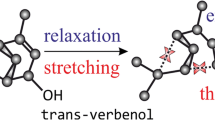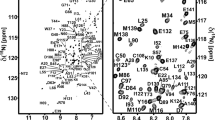Abstract
The ground and excited states of the pheromone molecules produced by xylophagous insects (the bark beetle Ips typographus L., the black fir sawyer beetle Monochamus urussovi Fisch., and the black pine sawyer M. galloprovincialis Oliv.) were modeled using a quantum chemical method utilizing DFT (density functional theory) with the B3LYP functional. The absorption wavelengths (energies) and dipole moments were calculated; the transitions of electrons from occupied to empty molecular orbitals were considered. The computed data were used to assess the stability of pheromone molecules exposed to environmental factors, such as solar radiation and humidity.
Similar content being viewed by others
References
K. V. Lebedev, V. A. Minyailo, and Yu. B. Pyatnova, Insect Pheromones (Nauka, Moscow, 1984) [in Russian].
F. Schlyter, G. Birgersson, and A. Leufven, J. Chem. Ecol. 15 (8), 2263 (1989).
J. Bergmann, L. Reyes-Garcia, C. Ballesteros, et al., Neotrop. Entomol. 45 (4), 351 (2016).
S. Quarrell and N. W. Davies, Chemoecology 26 (5), 183 (2016). doi 10.1007/s00049-016-0216-y
Z. Zhang and T. Zhang, Chemoecology 26 (1), 25 (2016).
S. M. Seo and J. M. Lee, J. Porous Mater. 23 (2), 557 (2016).
P. Landolt and Q.-H. Zhang, J. Chem. Ecol. 42, 655 (2016). doi 10.1007/s10886-016-0721-z
C. Ioriatti and A. Lucchi, J. Chem. Ecol. 42 (7), 57 (2016). doi 10.1007/s10886-016-0722-y
K. A. Hamby and D. E. Bellamy, J. Pest Sci. 89 (3), 605 (2016).
V. Party, C. Hanot, D. Sch. Busser, et al., PLOS ONE 8 (1), e52897 (2013). doi 10.1371/journal. pone.0052897
A. V. Kovalev and P. E. Volkova (Tsikalova), Sib. Lesn. Zh. 3, 93 (2015).
K.-E. Kaissling, J. Comp. Physiol. A 199 (11), 879 (2013).
H. Lei and H.-Y. Chiu, J. Comp. Physiol. A 199 (11), 997 (2013).
www.pherobase.com.
V. D. Ivanov, Soros. Obraz. Zh. 6, 29 (1998).
L. J. Wadhams, M. E. Angst, and M. M. Blight, J. Chem. Ecol. 8, 477 (1982).
J. C. Dickens, J. Chem. Ecol. 10, 1759 (1984).
J. C. Dickens, Entomol. Exp. Appl. 52, 191 (1989).
F. N. Tomilin, O. V. Osina, A. A. Kuzubov, et al., Biophysics (Moscow) 56 (4), 695 (2011).
R.-W. Shi and F. Liu, J. Mol. Model. 22, 140 (2016).
V. G. Sukhovol’skii, F. N. Tomilin, P. V. Artyushenko, and P. E. Tsikalova, Sib. Lesn. Zh. 3, 67 (2016).
A. Bakke and L. Riege, in Insect Suppression with Controlled Release Pheromone Systems, Ed. by A. F. Kydonieus and M. Beroza (CRC Press, Boca Raton, FL, 1982), Vol. 2, pp. 3–15.
A. Bakke, O. Austara, and H. Pettersen, Med. Norsk Inst. Skogsforskn. 33 (6), 255 (1977).
A. D. Maslov, The European Spruce Bark Beetle and Spruce Forest Die-off (VNIILM, Moscow, 2010) [in Russian].
A. S. Isaev, A. S. Rozhkov, and V. V. Kiselev, The Fir Sawyer Beetle (Nauka, Novosibirsk, 1988) [in Russian].
P. M. Naves, E. M. de Sousa, and J. A. Quartau, J. Appl. Entomol. 131, 669 (2007).
J. D. Allison, J. H. Borden, R. L. McIntosh, et al., J. Chem. Ecol. 27, 633 (2001).
N. Nabil, State of the Art on the Monitoring of the Pine Wood Nematode–PWN (Bursaphelenchus xylophilus) and its Insect Vector (Monochamus galloprovincialis) in Europe (Institut Européen de la forét cultivée EFIATLANTIC, 2009).
A. Kolk, The Atlas of Forest Insect Pests (Polish Forest Research Institute, Warszawa, 1996).
E. N. Pal’nikova, I. V. Sviderskaya, and V. G. Sukhovol’skii, The Bordered White in Siberian Forests (Nauka, Novosibirsk, 2002) [in Russian].
A. N. Nesmeyanov, Fundamentals of Organic Chemistry (Khimiya, Moscow, 1974) [in Russian].
V. V. Plemenkov, The Chemistry of Isoprenoids (Altai State Univ., Barnaul, 2007) [in Russian].
G. Birgersson, F. Schlyter, J. Löfqvist, and G. Bergström, J. Chem Ecol. 10 (7), 1029 (1984).
E. Pettersson and W. Boland, Chemoecology 13, 27 (2003).
J. A. Pajares, G. Alvarez, F. Ibeas, et al., J. Chem. Ecol. 36 (6), 570 (2010).
F. Ibeas, J. J. Diez, and J. A. Pajares, J. Insect Behav. 21, 101 (2008).
F. Ibeas, D. Gallego, J. J. Diez, et al., J. Appl. Entomol. 131, 13 (2007).
C. Lee, W. Yang, and R. G. Parr, Phys. Rev. B 37, 785 (1988).
A. D. Becke, Phys. Rev. A 38, 3098 (1988).
B. Miehlich, A. Savin, H. Stoll, and H. Preuss, Chem. Phys. Lett. 157, 200 (1989).
M. W. Schmidt, K. K. Baldridge, J. A. Boatz, et al., Comput. Chem. 14, 1347 (1993).
E. Runge, and E. K. U. Gross, Phys. Rev. Lett. 52 (12), 997 (1984).
M. Petersilka, U. J. Gossmann, and E. K. U. Gross, Phys. Rev. Lett. 76 (8), 1212 (1996).
L. A. Curtiss, K. Raghavachari, P. C. Redfern, and J. A. Pople, J. Chem. Phys. 106 (3), 1063 (1997).
L. A. Curtiss, P. C. Redfern, and K. Raghavachari, J. Chem. Phys. 123, 124107 (2005).
J. Tirado-Rives and W. L. Jorgensen, J. Chem. Theory Comput. 4, 297 (2008).
K. L. Schuchardt, B. T. Didier, T. Elsethagen, et al., J. Chem. Inf. Model. 47 (3), 1045 (2007).
D. Feller, J. Comp. Chem. 17 (13), 1571 (1996).
P. V. Artyushenko, F. N. Tomilin, A. A. Kuzubov, et al., J. Struct. Chem. 57 (2), 287 (2016).
J. Liu and R.-W. Shi, J. Environ. Entomol. 2, 424 (2016).
Author information
Authors and Affiliations
Corresponding author
Additional information
Original Russian Text © P.V. Artyushenko, F.N. Tomilin, A.A. Kuzubov, S.G. Ovchinnikov, P.E. Tsikalova, T.M. Ovchinnikova, V.G. Soukhovolsky, 2017, published in Biofizika, 2017, Vol. 62, No. 4, pp. 657–664.
Rights and permissions
About this article
Cite this article
Artyushenko, P.V., Tomilin, F.N., Kuzubov, A.A. et al. The stability of the pheromones of xylophagous insects to environmental factors: An evaluation by quantum chemical analysis. BIOPHYSICS 62, 532–538 (2017). https://doi.org/10.1134/S0006350917040029
Received:
Accepted:
Published:
Issue Date:
DOI: https://doi.org/10.1134/S0006350917040029




